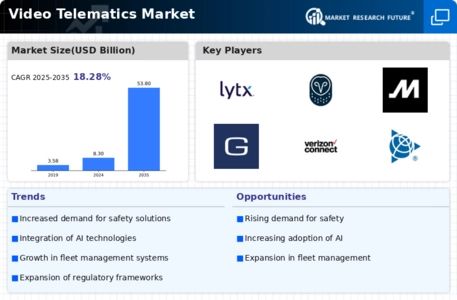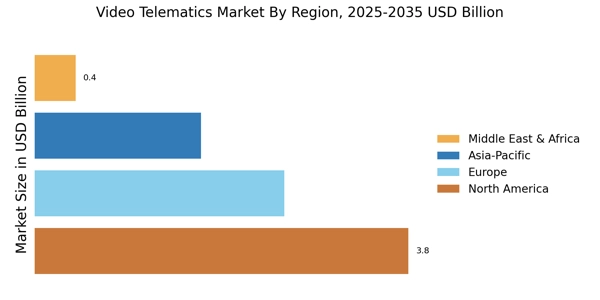Enhanced Safety Regulations
The Video Telematics Market is experiencing a surge in demand due to the implementation of enhanced safety regulations across various sectors. Governments and regulatory bodies are increasingly mandating the use of telematics systems to monitor driver behavior and vehicle performance. This trend is particularly evident in the transportation and logistics sectors, where compliance with safety standards is paramount. The integration of video telematics solutions allows companies to not only adhere to these regulations but also to improve overall safety metrics. As a result, the market is projected to grow significantly, with estimates suggesting a compound annual growth rate of over 20% in the coming years. This regulatory push is likely to drive investments in advanced telematics technologies, further solidifying the Video Telematics Market's position.
Increased Focus on Insurance Cost Reduction
The Video Telematics Market is also being driven by an increased focus on reducing insurance costs. Insurers are increasingly offering discounts to businesses that implement telematics solutions, as these systems provide valuable data that can mitigate risks. By utilizing video telematics, companies can demonstrate their commitment to safety and risk management, which can lead to lower premiums. This trend is particularly relevant in sectors such as transportation and logistics, where insurance costs can be substantial. As more businesses recognize the financial benefits associated with telematics, the market is likely to see a rise in adoption rates. Estimates suggest that the integration of video telematics could reduce insurance costs by up to 30%, making it an attractive proposition for many organizations.
Growing Demand for Fleet Management Solutions
The Video Telematics Market is witnessing a notable increase in the demand for fleet management solutions. Companies are increasingly recognizing the value of real-time data analytics and video monitoring in optimizing fleet operations. The ability to track vehicle locations, monitor driver behavior, and analyze performance metrics has become essential for businesses aiming to enhance efficiency and reduce operational costs. According to recent data, the fleet management segment is expected to account for a substantial share of the overall telematics market, with projections indicating a growth rate of approximately 15% annually. This trend underscores the importance of video telematics in providing actionable insights that can lead to improved decision-making and resource allocation within the fleet management sector.
Rising Consumer Expectations for Transparency
The Video Telematics Market is increasingly shaped by rising consumer expectations for transparency and accountability. Customers are demanding more visibility into the operations of service providers, particularly in sectors such as transportation and delivery. Video telematics solutions offer a means to provide this transparency, allowing companies to share real-time data and video footage with clients. This not only enhances customer trust but also improves service quality. As businesses strive to meet these expectations, the demand for video telematics is likely to grow. Market analysts indicate that companies adopting these technologies can expect to see improved customer satisfaction and retention rates, further driving the expansion of the Video Telematics Market.
Technological Advancements in Video Analytics
Technological advancements in video analytics are significantly influencing the Video Telematics Market. Innovations in artificial intelligence and machine learning are enabling more sophisticated video analysis capabilities, allowing for real-time monitoring and incident detection. These advancements facilitate the automatic identification of risky driving behaviors, such as harsh braking or rapid acceleration, which can be crucial for fleet safety and efficiency. The market is expected to benefit from these technological improvements, with analysts predicting a rise in adoption rates as businesses seek to leverage cutting-edge solutions. Furthermore, the integration of cloud computing with video telematics systems is likely to enhance data storage and accessibility, making it easier for companies to utilize video data effectively.


















Leave a Comment